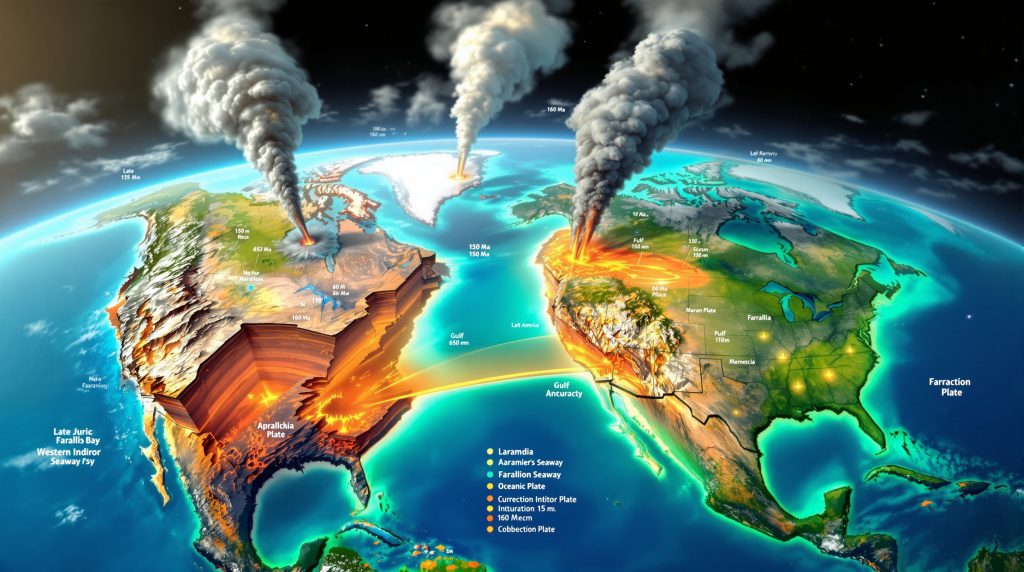Defining North America's Ancient Foreland System
The tectonic evolution of western interior basin represents one of Earth's most extensively documented foreland basin systems, stretching over 5,000 kilometres from the Arctic Ocean to the Gulf of Mexico during the Cretaceous period. This massive sedimentary depression formed through complex interactions between subducting oceanic plates and the North American craton, creating an unparalleled geological archive spanning approximately 80 million years.
Modern remnants of this ancient basin system extend across Wyoming, Colorado, Montana, Alberta, Saskatchewan, and Manitoba, preserving detailed records of past climates, ocean chemistry, and biological evolution. Furthermore, comprehensive mineral exploration insights from this region continue to reveal the basin's asymmetric geometry.
The basin features depths exceeding 2,000 metres along its western margin transitioning to 200-500 metres in eastern regions. This reflects its classification as a retroarc foreland basin system formed by flexural subsidence of the North American craton.
Geographic Scope and Geological Significance
The Western Interior Basin's extraordinary dimensions during maximum transgression around 85 million years ago included widths reaching 800-1,000 kilometres across Montana and Wyoming regions. Unlike typical oceanic basins, this epicontinental seaway maintained relatively shallow depths, with average depths ranging 50-200 metres and maximum depths likely between 300-600 metres in basin centres.
These measurements contrast significantly with deeper oceanic environments, reflecting the basin's unique position as an intracontinental seaway. The basin's sedimentary succession contains over 200 described ammonite species, providing exceptional biostratigraphic control for temporal correlations across vast geographic distances.
Farallon Plate Subduction and Continental Flexure
The basin's formation resulted from westward-dipping subduction of oceanic plates beneath the North American continent. As Farallon and Kula plates descended into the mantle between 160-66 million years ago, they generated compressive forces that simultaneously uplifted the ancestral Rocky Mountains while creating flexural depression eastward across the cratonic interior.
Critical Tectonic Timeline and Geochronological Constraints
High-precision radiometric dating provides unprecedented temporal resolution for understanding basin evolution. Consequently, the Western Interior Basin represents a classic example of foreland basin development:
- Late Jurassic (160-145 Ma): Initial foreland basin development coinciding with Nevadan orogeny
- Early Cretaceous (145-100 Ma): Accelerated subsidence and Sevier orogeny thrust belt development
- Mid-Cretaceous (~100 Ma): Critical transition marked by slab breakoff and postcolisional magmatism
- Late Cretaceous (90-66 Ma): Basin filling phases and Laramide orogeny initiation around 80 Ma
Argon-argon dating of bentonite beds within the Mowry Shale yields ages between 98.3 ± 0.5 Ma and 97.5 ± 0.4 Ma. In addition, uranium-lead zircon analyses provide even tighter constraints with uncertainties of ±0.2-0.3 million years. This precision enables correlation of geological events across the entire basin system.
Flexural versus Dynamic Subsidence Mechanisms
Traditional flexural models based solely on thrust-sheet loading cannot adequately explain the basin's extraordinary characteristics:
- Basin width exceeding 1,000 kilometres in places
- Systematic eastward migration of forebulge over 600+ kilometres
- Timing relationships between subsidence patterns and thrust belt activity
Dynamic topography models incorporating mantle flow beneath the subducting Farallon slab provide superior explanations for observed subsidence patterns. This is particularly evident during the critical 90-84 million year interval when maximum basin development occurred.
The effective elastic thickness of North American cratonic lithosphere during mid-Cretaceous time ranged between 100-200 kilometres. This reflects the cold, thick nature of Precambrian cratonic lithosphere. This rigidity produced flexural wavelengths of 1,000-1,200 kilometres, consistent with the approximately 600-kilometre distance from thrust front to structural features like the Black Hills.
Formation and Characteristics of the Continental Seaway
During peak Cretaceous greenhouse conditions, rising global sea levels combined with tectonic subsidence created the Western Interior Seaway. This effectively divided North America into western Laramidia and eastern Appalachia landmasses. This shallow marine corridor represented one of Earth's most extensive epicontinental seas.
Seaway Dimensions and Paleoenvironmental Conditions
At maximum transgression around 85 million years ago, the seaway exhibited remarkable dimensions:
| Parameter | Measurement |
|---|---|
| Maximum Width | 800-1,000 km (Montana-Wyoming) |
| Total Length | >5,000 km (Arctic to Gulf) |
| Average Depth | 50-200 metres |
| Maximum Depth | 300-600 metres (basin centres) |
Unique Oceanographic Circulation Patterns
The seaway's north-south orientation created meridional circulation patterns fundamentally different from typical oceanic basins. Restricted exchange with global oceans led to development of distinct water masses characterised by:
- Density stratification: Warm, saline surface waters overlying cooler, less saline bottom waters
- Periodic anoxia: Sluggish bottom-water circulation resulting in oxygen-depleted conditions
- Enhanced organic matter preservation: Creating today's hydrocarbon source rocks
These circulation restrictions, particularly during sea-level highstands, resulted in episodic anoxic events preserved as organic-rich shale horizons throughout the basin succession.
Eastward Migration Patterns and Sedimentary Architecture
Stratigraphic analysis reveals systematic eastward migration of depositional systems over distances exceeding 600 kilometres. This documents the progressive advance of flexural bulge across the continental interior. Furthermore, this migration pattern represents one of the most compelling pieces of evidence for the tectonic evolution of western interior basin.
Progressive Eastward-Younging Sequences
The eastward migration manifests through age-progressive formations:
- Black Leaf Formation (Montana): 105-100 Ma
- Muddy Sandstone (Wyoming): 100-98 Ma
- Newcastle Sandstone (eastern Wyoming/South Dakota): 98-96 Ma
- Canadian equivalents (Viking, Bow Island formations): Similar temporal progression
This represents migration rates of approximately 60-100 kilometres per million years, far exceeding distances explainable by simple thrust loading mechanisms.
Bentonite Beds as Chronostratigraphic Frameworks
Volcanic ash layers provide exceptional temporal resolution for basin correlation. Individual bentonite beds, some traceable for 500-1,000+ kilometres, enable precise dating with uncertainties of ±30,000-50,000 years. The Mowry Shale alone contains up to 55 bentonite beds within approximately 60 metres of section.
This represents volcanic ash frequency of one bed per 0.5-2 metres during certain intervals. Major regional bentonite markers include:
- Clay Spur Bentonite (~94 Ma)
- Ardmore Bentonite (Cenomanian)
- Multiple numbered Mowry Shale bentonites
Chemical fingerprinting using rare earth element patterns allows bed-to-bed correlation across vast distances. This creates a robust chronostratigraphic framework for understanding basin evolution.
Clastic Wedge Development and Deltaic Systems
Major sediment influx from rising Cordilleran highlands created extensive clastic wedges prograding eastward across basin floors. Research identifies five primary deltaic dispersal systems:
- Dunvegan Formation deltaic complex (Canada): Northwestern-derived sediments
- Viking Formation systems (Canada): Multiple delta lobes
- Frontier Formation (Wyoming): Western-sourced clastic wedges
- Mesaverde Group (Colorado): Major progradational sequences
- Various smaller strike-parallel systems
Individual prodeltaic clinoforms extend over 800 kilometres from source areas. This demonstrates the extraordinary scale of sediment transport systems during basin development.
Geochemical Evidence for Westward Subduction
Trace element analysis of Cretaceous volcanic rocks reveals fundamental compositional transitions around 100 million years ago. This provides crucial evidence for the tectonic evolution of western interior basin through westward-directed subduction processes.
Magmatic Compositional Transitions
The geochemical signature shift documents the transition from arc-type to postcolisional magmatism. For instance, detailed drilling results analysis reveals:
Pre-100 Ma Characteristics:
- High Sr/Y ratios indicating garnet-bearing source regions
- Depleted heavy rare earth element (HREE) patterns
- Typical subduction zone arc signatures
Post-100 Ma Characteristics:
- Lower Sr/Y ratios reflecting crustal melting
- Enriched HREE patterns
- Postcolisional alkaline compositions
Crows Nest Volcanics and Alkaline Magmatism
Within Canadian Cordilleran foothills, nearly 500 metres of alkaline volcanic rocks interfinger with conglomerates. These are dated at 102.9 ± 1 million years through uranium-lead analyses of xenocrystic garnets. These Crows Nest volcanics display distinctive alkaline signatures including phenocrysts of alkali feldspar and black melanite garnet xenocrysts within clinopyroxene-dominated matrices.
Trace element compositions of these alkaline volcanics closely match those of bentonite samples from basin interior. This suggests common postcolisional magmatic sources following slab breakoff around 100 million years ago.
Structural and Thermochronological Evidence
Thermochronological data from basement massifs documents systematic exhumation onset at approximately 100 million years ago. This coincides with the proposed timing of slab breakoff and initiation of postcolisional tectonism. This timing appears consistent across multiple mountain ranges from Montana south through Utah and Nevada.
Evidence includes:
- Beartooth and Madison ranges (Montana): Exhumation initiation at ~100 Ma
- Charleston, Nebo, and Canyon ranges (Utah): Similar timing constraints
- Iron Springs and Muddy thrusts: Associated debris dated to ~100 Ma
Cretaceous Greenhouse Climate and Eustatic Controls
The Cretaceous period represents one of Earth's most extreme greenhouse intervals, with atmospheric CO₂ levels potentially 3-6 times higher than present values. These elevated temperatures drove enhanced continental weathering, increased sediment production, and maintained elevated global sea levels critical for Western Interior Seaway development.
Third-Order Eustatic Cyclicity
Cyclical sea level fluctuations with 1-5 million year durations created repeated transgressive-regressive sequences throughout the basin. These cycles appear particularly well-expressed in limestone-shale alternations of the Niobrara Formation. Here, orbital-scale climate variations are preserved in sedimentary rhythms.
The systematic nature of these cycles suggests global eustatic control rather than purely local tectonic influences. This indicates the importance of climatic forcing in basin development patterns.
Oceanic Anoxic Events and Carbon Cycle Perturbations
Several oceanic anoxic events during the Cretaceous left distinctive geochemical signatures in basin sediments. The Cenomanian-Turonian Oceanic Anoxic Event 2 (~94 Ma) appears particularly well-preserved, providing insights into global carbon cycle perturbations during extreme greenhouse conditions.
These anoxic intervals coincide with:
- Enhanced organic matter preservation
- Distinctive carbon isotope excursions
- Development of important hydrocarbon source rocks
The Fish Scales Formation and equivalent units represent condensed anoxic horizons traceable across the entire basin. These form essentially isochronous surfaces during critical periods of basin evolution.
Marine and Terrestrial Evolutionary Radiations
The Western Interior Seaway supported remarkably diverse marine ecosystems while its margins witnessed significant terrestrial evolutionary developments during the mid-Cretaceous interval.
Marine Ecosystem Diversification
Basin marine environments supported extensive faunal communities including:
Ammonites:
- Over 200 described species providing exceptional biostratigraphic control
- Endemic Neogastroplites species characterising early Cenomanian intervals
- Five distinct ammonite zones recognised within Mowry Shale equivalents
Bivalves:
- Giant inoceramid suspension feeders reaching diameters exceeding one metre
- Diverse assemblages adapted to restricted circulation conditions
Marine Vertebrates:
- Mosasaurs, plesiosaurs, and marine crocodilians
- Diverse fish assemblages preserved in organic-rich shales
- Abundant fish scales, bones, and teeth in condensed horizons
Terrestrial Biological Innovations
Basin marginal environments witnessed critical evolutionary developments. Meanwhile, the mining industry evolution has enabled modern researchers to access previously inaccessible fossil localities:
Flowering Plant Radiation:
Angiosperm diversification accelerated during mid-Cretaceous intervals, fundamentally altering terrestrial ecosystems and sediment production patterns.
Dinosaur Evolution:
The arrival of Asian immigrant taxa during mid-Cretaceous time included tyrannosaurs, ceratopsians, and various hadrosaurian lineages. This suggests enhanced biogeographic connections facilitated by tectonic accretion processes.
Mammalian Diversification:
Early placental and marsupial radiations occurred alongside snake evolution, indicating comprehensive terrestrial ecosystem reorganisation during basin development.
Biogeographic Barriers and Connections
During peak transgression, the Western Interior Seaway created effective biogeographic barriers, resulting in:
- Laramidia (western landmass): Distinct dinosaur faunas including endemic tyrannosaurid and ceratopsian assemblages
- Appalachia (eastern landmass): Poorly preserved but apparently distinct endemic faunas
Paleontological evidence suggests tectonic accretion of exotic terranes facilitated biological exchange between Asia and North America. This introduced taxonomic groups that fundamentally altered North American ecosystems.
Contemporary Basin Analogues and Modeling Approaches
Modern foreland basin systems provide valuable insights into processes that shaped the tectonic evolution of western interior basin. The Po Basin in northern Italy and Persian Gulf foreland systems demonstrate active relationships between tectonics, climate, and sedimentation observable in real-time.
Additionally, research on modern sedimentary basin formation provides crucial comparative frameworks for understanding ancient systems.
Advanced Numerical Modeling Techniques
Next-generation computational models integrating plate kinematics, mantle dynamics, and surface processes enable quantitative testing of basin evolution hypotheses. These models successfully reproduce observed subsidence patterns when dynamic topography effects are incorporated alongside traditional flexural mechanisms.
Key modeling insights include:
- Dynamic subsidence significance: Mantle flow patterns beneath subducting slabs contributed substantially to basin deepening
- Flexural parameter constraints: Effective elastic thickness values of 100-200 km for cratonic lithosphere
- Migration mechanism validation: Eastward forebulge migration over 600+ km distances
Hydrocarbon Exploration Applications
Understanding Western Interior Basin evolution directly informs petroleum exploration strategies worldwide. The basin's well-characterised source rock intervals include:
Mowry Shale:
- Total Organic Carbon (TOC) typically 1-4%, locally exceeding 6%
- Type II kerogen with excellent hydrocarbon generation potential
- Extensive lateral continuity enabling regional resource assessments
Additional Source Rocks:
- Skull Creek Shale (TOC 1-3%)
- Niobrara Formation organic-rich intervals (TOC 1-5%)
- Various Mancos Shale equivalents
These formations serve as exploration templates for similar foreland basin systems globally. This demonstrates the practical applications of fundamental basin research.
Resource Development and Economic Geology
The Western Interior Basin contains extensive energy and mineral resources formed during its complex tectonic evolution. Understanding mineral deposit tiers helps evaluate the basin's resource potential across different economic categories.
Coal Resource Distribution and Formation
Basin coal deposits formed during periods of high accommodation space and humid climate conditions. This occurred primarily during latest Cenomanian through middle Maastrichtian intervals when peat accumulated in rapidly subsiding coastal environments.
Coal Distribution Patterns:
| Basin Region | Characteristics |
|---|---|
| Western Margin | Thick, laterally continuous seams |
| Central Basin | Thinner, discontinuous deposits |
| Eastern Margin | Limited development due to marine influence |
Coal formation required specific combinations of:
- High accommodation space creation rates
- Abundant organic matter input from coastal vegetation
- Rapid burial preventing oxidation
- Appropriate water table fluctuations
Unconventional Hydrocarbon Systems
Organic-rich shales within basin sequences represent substantial unconventional hydrocarbon resources. The Mowry Shale and equivalent formations contain Type II kerogen derived from marine organic matter, exhibiting excellent source rock characteristics.
Recent technological advances in horizontal drilling and hydraulic fracturing have enhanced economic viability of these resources. This makes previously inaccessible hydrocarbons commercially recoverable.
Carbon Sequestration Potential
Basin extensive saline aquifer systems and depleted hydrocarbon reservoirs present significant opportunities for geological carbon storage. These formations offer:
- Large pore volumes for CO₂ storage
- Appropriate depth ranges for supercritical CO₂ conditions
- Proven seal rock integrity from hydrocarbon retention
- Established infrastructure from existing energy development
Such carbon sequestration applications contribute to climate change mitigation strategies while utilising geological understanding developed through basin research.
Emerging Research Directions and Future Studies
Contemporary research on the tectonic evolution of western interior basin continues advancing through integration of cutting-edge analytical techniques, high-resolution datasets, and sophisticated computational approaches.
Integrated Basin Modeling Advances
Next-generation basin models incorporate:
- High-resolution 3D seismic data providing unprecedented subsurface imaging
- Advanced geochemical analysis including clumped isotope thermometry and molecular biomarkers
- Machine learning algorithms for pattern recognition in complex datasets
- Coupled fluid flow and geomechanical modeling for resource development optimisation
These technological advances promise refined understanding of basin evolution processes while enabling more accurate predictions for resource exploration.
Climate System Interactions Research
Ongoing investigations focus on quantifying feedbacks between basin development, regional climate patterns, and global carbon cycle dynamics during Cretaceous greenhouse intervals. Research areas include:
- Paleoclimate model validation using basin sedimentary records
- Weathering rate quantification during extreme greenhouse conditions
- Ocean-atmosphere interaction modeling for epicontinental seaway systems
- Vegetation feedback mechanisms influencing sediment production and composition
Comparative Planetology Applications
Western Interior Basin research benefits studies of sedimentary systems on Mars and other planetary bodies where similar processes may have operated under different boundary conditions. Comparative approaches examine:
- Sedimentary structure formation under varying gravitational and atmospheric conditions
- Preservation potential of organic matter and biosignatures
- Fluid flow patterns in extraterrestrial sedimentary systems
- Tectonic influences on basin development across different planetary contexts
Synthesis of Continental-Scale Basin Evolution
The tectonic evolution of western interior basin exemplifies how plate tectonic processes, climatic dynamics, and biological evolution interact to create continental sedimentary systems of global significance. Its development through Farallon plate subduction, dynamic mantle processes, and Cretaceous greenhouse conditions produced one of Earth's most complete records of mid-Cretaceous environmental change.
The basin's evolution from initial foreland subsidence through seaway development to final closure demonstrates the complex interplay between:
- Plate boundary processes driving long-term subsidence patterns
- Mantle dynamics controlling regional elevation changes
- Global climate systems influencing sea level and sedimentation
- Biological evolution affecting ecosystem structure and carbon cycling
Modern analytical techniques, from high-precision geochronology to sophisticated numerical modeling, continue refining understanding of this remarkable geological system. The integration of multiple datasets and approaches ensures continued relevance to Earth system science while providing practical applications for resource exploration and environmental management.
However, understanding the relationship between basin evolution and critical minerals and energy security becomes increasingly important as global energy transitions accelerate. The Western Interior Basin stands as a premier example of how fundamental geological research contributes to broader scientific understanding while addressing contemporary societal challenges including energy security, climate change mitigation, and sustainable resource development.
Its continued study promises new insights into Earth system evolution while informing strategies for managing our planet's geological resources.
Disclaimer: This analysis synthesises current scientific understanding of Western Interior Basin evolution. Geological interpretations continue evolving as new data and analytical techniques become available. Resource development estimates and climate reconstructions involve inherent uncertainties that should be considered in practical applications.
Looking to Invest in Mineral-Rich Foreland Basin Systems?
Discovery Alert's proprietary Discovery IQ model instantly identifies significant ASX mineral discoveries in complex geological environments like foreland basins, transforming intricate geological data into actionable investment opportunities. Begin your 30-day free trial today to stay ahead of the market when the next major discovery is announced across Australia's diverse sedimentary systems.




